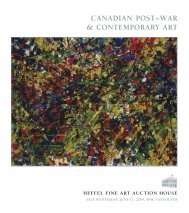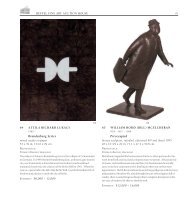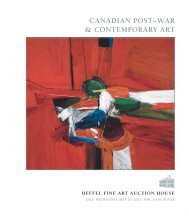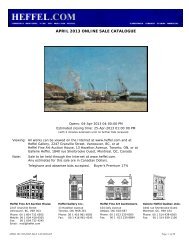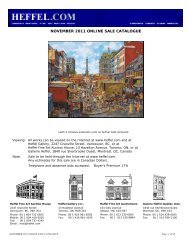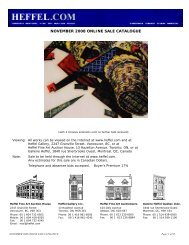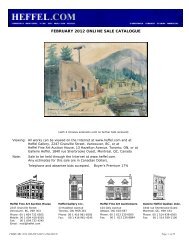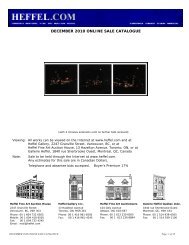CANADIAN POST~WAR & CONTEMPORARY ART - Heffel
CANADIAN POST~WAR & CONTEMPORARY ART - Heffel
CANADIAN POST~WAR & CONTEMPORARY ART - Heffel
You also want an ePaper? Increase the reach of your titles
YUMPU automatically turns print PDFs into web optimized ePapers that Google loves.
HEFFEL FINE <strong>ART</strong> AUCTION HOUSE 37<br />
26 JACK LEONARD SHADBOLT<br />
BCSFA CGP CSPWC OC RCA 1909 ~ 1998<br />
The Great Ones<br />
oil and casein on board, signed and on verso<br />
signed J.L. Shadbolt, 128 Monroe St., N.Y.C.,<br />
titled, dated 1948 and inscribed oil on casein study<br />
for large canvas, $250<br />
24 x 35 1/2 in, 61 x 90.2 cm<br />
PROVENANCE:<br />
Claude Bouchard, Ottawa<br />
Private Collection, Vancouver<br />
LITERATURE:<br />
Scott Watson, Jack Shadbolt, 1990, page 57, this painting, as well as the<br />
related watercolour, reproduced page 61<br />
EXHIBITED:<br />
Montreal Museum of Fine Arts, 67th Annual Spring Exhibition,<br />
March 14 ~ April 9, 1950<br />
Jack and Doris Shadbolt spent one year in New York City from September<br />
1948 to August 1949. The year~long “sabbatical” was supported by the<br />
Department of Veterans Affairs which, however, stipulated that Shadbolt<br />
be enrolled in a program of study. He registered at the Art Students<br />
League, where one of his instructors was Vaclav Vylacil, himself a former<br />
student of Hans Hofmann. Vylacil’s circle included Arshile Gorky, who<br />
had died by his own hand only weeks before the arrival of the Shadbolts.<br />
Shadbolt also enrolled in a mythology course at the New School for Social<br />
Research. In that course, where he made copious notes, the lecturers<br />
emphasized the need to reintroduce myth to a culture of damaged<br />
psyches.<br />
The year 1948 ~ 1949 was a critical one for the emergence of the painters<br />
who would be known as the New York School, roughly bracketed by the<br />
death of Gorky and an important exhibition at Samuel M. Kootz Gallery<br />
in September 1949 that helped define the new movement. But at the time,<br />
artists like Karl Knaths and Felix Ruvolo were better known than Jackson<br />
Pollock or Barnett Newman. Although Shadbolt did see and review<br />
Pollock’s first exhibition at Betty Parsons’ Gallery, he was less than<br />
enthusiastic about the drip paintings. As it was for Vylacil and many<br />
others, Shadbolt’s ideal remained Picasso. He had seen the model<br />
painting for the reigning mode of biomorphic abstraction, Picasso’s<br />
Guernica, when it was first shown at the 1937 Paris World’s Fair. For<br />
many artists, Guernica exemplified the possibility of social engagement<br />
in contemporary art. Drawing on so~called primitive art, Surrealism and<br />
experiments in abstraction, the Picasso painting was seen as a way to<br />
connect the crises of history to both eternal verities and new modern<br />
experiences.<br />
In the year before traveling to New York, Shadbolt had already turned<br />
away from Social Realism. His great facilities as a draughtsman had made<br />
him a celebrated artist in Canada, but in 1947 he began to experiment<br />
with abstraction. It was primarily his experience in bombed and ruined<br />
London after World War II, working in the War Artists Administration<br />
where he processed the photographs coming in from Auschwitz, that<br />
made him feel realism was not up to the task of expressing the spirit of the<br />
times. Only abstraction could convey the kinds of anxieties brought on by<br />
the war, the Holocaust and the dawning of the atomic age. Abstraction<br />
had a transfiguring power and could “offer order to the spirit”. Shadbolt<br />
called this “symbolic abstraction”. “Although it will sound fantastical to<br />
many,” he wrote, “it could be maintained that this concept of symbolic<br />
abstraction offers us a new dimension of form replete with the<br />
psychological possibilities for a great human expression at the service<br />
of large social themes.”<br />
The Great Ones was painted in New York in 1948 as an allegorical<br />
symbolic abstraction (a related 1948 watercolour depicts two of the<br />
figures in the painting with a bluer palette). The title might make one<br />
think of the victorious war leaders Churchill, Stalin and Roosevelt. Yet<br />
their gender, more apparent in the oil painting than the watercolour, is<br />
female. Two of the figures have dog~like heads. Shadbolt often used dogs<br />
in his wartime paintings to represent sexuality on the one hand and<br />
anxiety on the other. On verso is inscribed “oil on casein study for a large<br />
canvas”. It is unlikely he ever executed the proposed larger work.<br />
Shadbolt must have been pleased with The Great Ones, as he chose to<br />
exhibit the work at the 67th Annual Spring Exhibition at the Montreal<br />
Museum of Fine Arts in 1950.<br />
Works such as The Great Ones mark the turning point in Shadbolt’s career,<br />
and in the decade after his return from his encounter with the New York<br />
scene, Shadbolt consolidated his reputation as one of Canada’s leading<br />
abstract painters.<br />
We thank Scott Watson, director of the Morris and Helen Belkin Gallery,<br />
University of British Columbia, for contributing the above essay.<br />
ESTIMATE: $60,000 ~ 80,000



